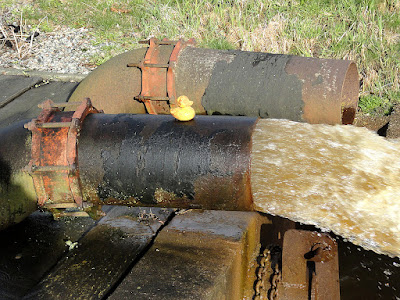The beach at White Rock is wide and flat and the sand goes out on the inner end of the bay almost to the American border. To the east, towards Kwomais Point, the sand quickly dwindles and the shore is first stony, then rocky, then rugged. At low tide, there are patches of sand at first, and we can make our way quickly to where large rocks, some taller than us, all covered with barnacles and mussels, stand dripping into pools at their bases. At the lowest tides, we can even walk around them on dry sand.
And here we can expect to find starfish and anemones, giant barnacles and bright whelks. There may be a large Dungeness crab in the pools, or stranded fish. And there are always surprises.
On many of these large rocks, this Thursday, we found bright orange patches of a compound ascidian, probably Violet Tunicate.
 |
| I think this is the same as the one I had in my aquarium last year. |
 |
| A young colony (right), showing the arrangement of siphons and "hearts". |
These tunicates come in various colours, from peach to a deep, winy red. There are other encrusting growths in the same colouring; this one can be distinguished by the more or less orderly rows of siphons, and the ends of blood vessels radiating around the edge. (The blood flows outward, then reverses direction; the outer tips have been called little individual hearts. A post from last year,
Chordate for a day, has more details.)
 |
| A red colony. |
 |
| I am uncertain about this one. I can't see the "hearts". It may be a sponge. |
On the last pair of rocks we reached, while Laurie was discovering his batch of
whelk eggs, I was checking the landward side of the largest rock yet. The lower half of the rock was home to large black barnacles, and around them yellow nipples, an inch or more long, hung from a jelly and slime base.
 |
| Sponge. Unidentified. |
 |
| The yellow tubes were surrounded by a transparent slime; tubes and slime covered all but the mouths of the barnacles. The tubes felt rubbery to the touch. |
I came out from behind the rock to call Laurie over to see these; he was bent over looking at something on his rock (the whelk egg cases, I found out later), but left them and hurried over to see what I wanted. He was in too much of a hurry, I guess, and took a direct path through some shallow water, where the deep mud sucked at his boots, his feet slipped, and he fell face down into the mud.
In the excitement of dragging him out of the mud while the mud fought back, getting him cleaned up, and patching a bleeding knee from a rock hidden under the muck, we forgot our finds. A pity; I should have gotten a sample of the sponge and a few macro photos. Another day, maybe.
My
Encyclopedia has 20 pages of sponges. None of them look quite like this one, except possibly the Breadcrumb sponge,
Halichondria panicea, which comes in a variety of shapes and colours. And names, too:
Halichondria panicea, popularly called "Breadcrumb Sponge," is the marine world's reigning champion of Latin aliases, with 56 synonyms appearing in taxonomic literature since its first description in 1766. Of no fixed address, it's known to frequent floats, pilings, and the underside of rocks, smells like exploded gunpowder and takes on many guises.
CREDIT: Bernard Picton and World Register of Marine Species (Live Science)
I didn't smell the gunpowder.
I was getting confused and frustrated, comparing all the different sponges in the
book and
on the web, so I was cheered up by the last 5 pages of the sponge section; 25 "Undetermined Sponges," and that's only "A Selection". Thank you,
Andy and
Bernard!
And in case you're wondering, Laurie's fine. He's limping a bit, but the cut on the knee wasn't deep. At least most of the mud gave him a soft landing.


















































